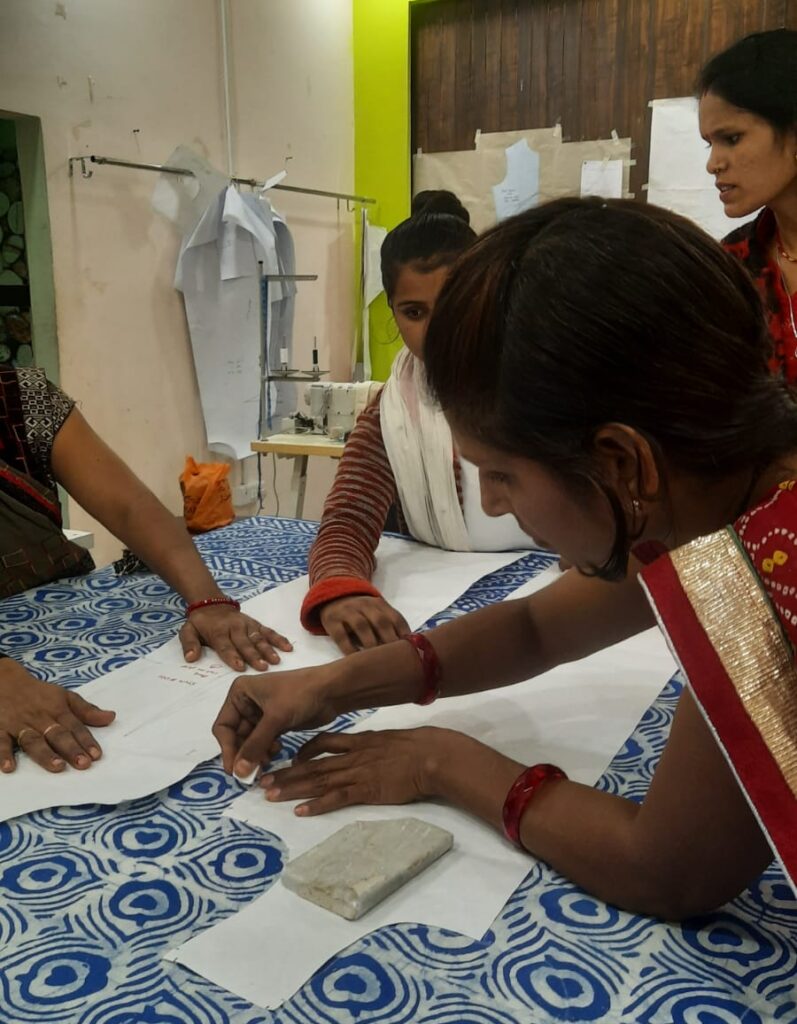Fun Fact: The piece of apparel you are currently wearing was potentially put together using a formula.
Have you ever wondered about how different pieces of fabric of different sizes come together to be built into a single piece of garment without any flaws? Constructing a garment is a mathematically rigorous process that requires extremely efficient skills and resources.
In October 2022, I got the opportunity to coordinate a 2.5-month-long training session in garment construction for women at Kala Kendra. Kala Kendra is a training and production center promoted by Kala Maitri in Ujjain and Maheshwar. The training was conducted by the industry expert Prof. Gajanan Dhapodkar. He was one of the founding professors of NIFT, Delhi. He also has experience in leading design schools like Pearl Academy.
The participants in the training were women SHG members belonging to rural and semi-urban areas of Maheshwar and Ujjain with an educational background of 4th-grade level to undergraduate level. The majority of our women had barely completed formal education until 8th-10th grade levels. This was a worrying concern for us as coordinators as to how women who barely understand maths, could grasp complex formulas. They had to use measurements, drafting patterns, grading, etc while using technical tools such as pattern masters, L-Scale, French Curve, etc.
As the training unfolded, observing women grasp these concepts using their learning methods was very interesting. As much as we encouraged them to make notes, we later realised that clicking videos was their alternative to making notes efficiently. Despite ending up pronouncing “measurement” as “management” they managed to do a good job of picking up the skill of measuring accurately.
As the training coordinator, the step-by-step process of designing, drafting, and constructing garments was very interesting for me to observe and learn. Bringing women who mostly spent their time in their households and kitchens back into a classroom setup where they had to observe, learn, unlearn, and practice with dedication was a very heart-warming process to observe. In this blog, I take you through the step-by-step process of garment construction from the classroom experience at Kala Kendra under Gajanan sir’s guidance.
1. Pattern Drafting
This is the part where you put a design you found interesting to paper. Pattern drafting is the process of drawing pattern pieces on paper, basis the design and measurement. A mathematically rigorous process where you use tools, formulas, and calculations to draft different pieces which will ultimately come together after cutting on fabric to become the final garment. While our women absolutely blanked out in the first week of the drafting session, 2.5 months of rigorous training helped build a good foundational understanding.
2. Marking

Marking refers to the process of placing pattern pieces to maximize the number of patterns that can be cut out of a given piece of fabric. Once the pattern is readied and the fabric is ironed and laid out, the pattern pieces are placed on the fabric to figure out the optimum consumption of fabric for cutting. This process is very important for large-scale production, where optimum usage of fabric is important to minimize wastage and cost. The nature of this process is relevant to management. I always found myself negotiating with women on marking in multiple ways to optimize efficiency.
3. Cutting
After marking the pattern out on the fabric, the patterns are traced on the fabric using chalks and then cut using Fabric Cutters or Siccors. This is one of the most crucial steps in fabric construction as any mistake here would result in irreversible damage and losses in the process.

4. Stitching
Stitching involves joining the different patterns cut together into a finished garment. This involves semi-skilled and skilled workers who work basis their potential. The stitches involved in construction include seam stitches, straight stitches, neck finishing, collars, sleeve attachments, facing, binding, piping, darts, tucks, pleats, etc.
5. Overlock
An overlock machine is a specialized stitch machine that sews over the edge of one or two pieces of cloth for edging, hemming, or seaming. It is used for providing edge finishes on the inside of garments. These machines operate with 3-4 threads running together which locks together unfinished fabric ends in the inside of the garment.

6. Fitting and dummy trial
Once the first draft of the garment is constructed, it is trialed on a dummy to understand the fitting better. The garment is then corrected basis fitting, to ready the final product. This is the final step post which your garment is ready to be ironed, folded, packed and shipped to the customer!

7. Grading

Once your base size pattern is created, and its fitting is perfected, what’s next? It is here that we use pattern grading to adjust the base pattern size into multiple sizes as required. “Pattern grading is the process of turning a sample size (sometimes referred to as base size) into additional smaller or larger sizes. Pattern grading is done using a size specification sheet. Grading does not create a new shape, it increases or decreases the size of the original shape of the garment”. The graded drafts are further used to mark, cut and stitch their respective garments. This is another complex process in drafting which requires rigorous calculations to grade sizes. As a coordinator, it was very interesting to see women figure out mathematical formulas to convert inches into centimeters and increase sizes basis the classroom discussion.
For us at Kala Kendra, it was a huge step and experience to facilitate a highly stimulating, rigorous, and demanding training of this sort for women who barely even know how to read and write. Yet, they embraced the opportunity to make the best out of it to the best of their capacities. Despite being a high-stress classroom, they did not fail to keep their calm and move forward steadfastly.
PS: Some photos in this story are owned by Prof. Gajanan Dhapodkar, used here with his permission.






0 Comments